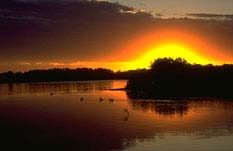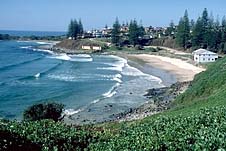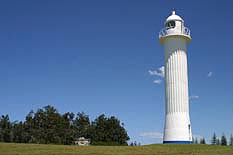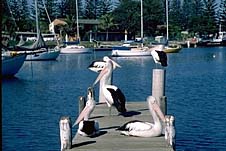
|
| Sunset over the Oyster
Channel, Yamba |
Yamba (including Angourie)
Attractive fishing village and holiday destination on the
far north coast.
Located 682 km north-east of Sydney, 18 km north-east of
Maclean and 29 m above sea-level, Yamba is a quiet
seaside town on the southern side of the Clarence River
estuary. Opposite, on the northern side of the river mouth,
is
Iluka.
Yamba is economically driven by its substantial fishing
fleet (the Clarence River is a major source of the nation's
seafood) and its capacity to draw those looking for a
relatively quiet holiday destination beside the sea. Of
course, some of those leisure-seekers are also drawn by the
fish.
The area was occupied by the Yaygir or Bundjalang
Aborigines at the time of European colonisation. These
people lived within a fairly small, well-defined area as the
plenitude of resources negated the need for lengthy
migrations. It also appears to have rendered them healthier
and taller than inland groups while their semi-sedentary
lifestyle reputedly fostered a superior material culture
(manifest in the quality of the domiciles, utensils, baskets
and fishing nets etc). European observers spoke highly of
their crafts, skills, mores, artefacts and intelligence.
While they coexisted peacefully with the timbergetters and
pastoralists, the advent of agriculture with the free
selectors of the 1860s destroyed their hunting grounds and
decimated the culture of the original inhabitants.
Matthew Flinders investigated the river mouth in 1799. He
landed on the southern headland near the present-day site of
Yamba and wrote about the lifestyle of the Aborigines he
came in contact with. However, he found the waters shallow
and dismissed the whole area as 'deserving of no more than a
superficial examination'. In fact, Flinders mistook the
inlet for a coastal bay and did not imagine there was a
major river nearby.
It is thought that convict escapees from Moreton Bay
passed through the area in the late 1820s and early 1830s.
One of their number, Richard Craig, reported a big river and
a plenitude of valuable timber when he arrived at Port
Macquarie in 1832. He was later employed by a Thomas Small
of Sydney who, inspired by Craig's reports, sent off his
brother and two dozen sawyers on board the schooner, the
Susan, to the 'Big River', as it was initially known. It was
the first European vessel to enter the river. Other
cedar-cutters followed in their wake. Small took up a large
parcel of land on Woodford Island, opening the way for other
landholders. Governor Gipps named the river the Clarence in
1839.
A pilot station was established on the future townsite in
1854 to aid vessels in crossing the river bar which was a
major obstacle to navigation for many years.
The townsite was surveyed in 1861 and growing commercial
traffic saw work begin on the construction of a breakwater
at the mouth of the river in 1862. The consequent influx of
workers and their families fostered the emergence of
commercial enterprises to meet their needs. The Woolli Hotel
and the first post office opened in 1862, the first school
in 1868, an Anglican church in 1871 and, in 1879, the first
police station and lighthouse. The latter was replaced in
1956.
Although the village had been gazetted as Yamba in 1864,
'Clarence River Heads' was the name the government bestowed
upon the pilot station, post office, school and police
station. Meanwhile the locals referred to the area as
'Woolli Woolli' or 'Wooli'. The confusion was only resolved
when the name 'Yamba' was officially proclaimed in 1885. The
meanings attributed to this Aboriginal word are various.
The population of the settlement varied according to
whether harbour works were in progress or not. Thus the
figure of 200 was put forward in 1862 and this had dropped
to 60 in 1866. The Australian Handbook recorded the
population as 35 in 1876 with 70 in the district. At that
time there were three inns but no public buildings except
the home of the resident engineer. By 1885 there were about
340 in the district. The township had two inns, a police
quarters and lock-up, and two stores.
By 1891 the Australian Handbook had changed its
description of the town from 'a post town and telegraph
office' to 'a favourite seaside resort', suggesting the
recent emergence of tourism. By this time there were 120 in
the town which boasted 'a large boarding house, two large
hotels, two small stores, post, money order, and a telegraph
office, gaol, lighthouse and a public school with an average
attendance exceeding 24'.
After further work on the breakwater commenced in 1893
the numbers swelled to 350, dropping to 250 when that work
ended in 1903. The town's population reached 689 in 1919 and
its reputation as a holiday destination was assisted by the
arrival of the Sydney railway at South Grafton in 1923.
However, the poor quality of the roads, dramatic sand drifts
which threatened to bury parts of the town, the Depression
and World War II retarded development and growth. Further
harbour works were carried out from 1952 until 1971 and
infrastructural improvements at this time saw a steady
growth from about 1000 people in the late 1960s to the
present 4572, although that number swells dramatically if
temporarily in holiday periods.
The town's reputation for recreational fishing was
greatly encouraged by the inauguration of an annual fishing
contest in 1958, initially hosted by famous radio
personality, Jack Davey, who retreated to Yamba to relax and
fish. The Yamba Family Fishing Festival is now held in
September or October.
The first shipment of fish to Sydney occurred in 1884.
Prawn trawling commenced in 1946 and has steadily expanded
to the point where over 600 tonnes of prawns are now trawled
each year, together with 1300 tonnes of fish. Clarence
oysters have also supplied the nation since at least the
1880s. Sand mining was also a major industry from 1934-1943
and again in the early 1970s.
Things to see:
![[Top of page]](smlArrow.gif)

|
| The view across the beach
from the lighthouse headland |
Tourist Information
The Lower Clarence Information Centre at Maclean can furnish
information regarding deep-sea fishing charters, a
self-drive tour of significant Aboriginal sites in the area,
whale-watching cruises, farm and industry tours and the
hiring-out of houseboats, fishing boats, surfskis,
catamarans, sailboards, jet-skis, canoes, rowboats,
motorboats, paddle boats and paddlebikes, tel: (02) 6645
4121.
The information centre has tide charts and guides to
fishing, though these should also be obtainable from the
marina. They also have a brochure entitled "Historical Walk
Around Yamba" which is also available at the Story House
Museum.

|
| Yamba lighthouse
|
Yamba Lighthouse
Yamba Lighthouse, on South Head, stands 41 m above the sea,
offering fine views of the coastline (it is a popular
whale-watching site in the winter months). Its beams can be
seen 17 km out to sea. The lighthouse is situated on Pilot
Hill at the end of Pilot St on South Head. Nearby is a
replica of the original 1879 lighthouse erected by
volunteers for use as a community radio station.
Beaches
Yamba has a number of beaches which are ideal for swimming
and surfing. Yamba Beach (patrolled in summer) is the main
beach in town. It has a rock pool for safe swimming and is
located on the southern side of the South Head lighthouse,
below Flinders Park. On the other side of the lighthouse
(nestled in the elbow formed by the junction of South Head
and the eastern side of the main breakwall) is Turner's
Beach which is also patrolled in summer. Whiting Beach is a
stillwater river beach which is suitable for young children.
It extends from the western side of the breakwall out along
the sand spit known as Hickey Island. Convent Beach extends
eastwards from the rock pool at the eastern edge of Yamba
Beach to Yamba Point. On the other side of Yamba Point is
Pippi Beach (also patrolled in summer) which extends south
to Angourie.

|
| Pelicans and boats at
Yamba |
Ferry
The Yamba to Iluka ferry operates daily from the River St
wharf. There are also river cruises to Harwood Island on
Wednesdays, Fridays and Sundays and another company has also
opened offering river cruises. Contact Clarence River
Ferries on (02) 6646 6423 or 018 664 556 for details of
departure times.
Story House Museum
Yamba's Story House Museum is open Wednesday, Saturday and
Sunday 2.00 p.m. to 5.00 p.m. It focuses on local history
and has some fine displays, including working models, a
miniature early schoolroom and an excellent photographic
collection. It is located adjacent the golf club at the end
of River St which runs off Wooli St (the main road). They
also have a brochure available entitled "Historical Walk
Around Yamba", tel: (02) 6646 2316.
Yuraygir National Park
Turn off the Yamba Rd (at the Pegasus Motel) and head south
along the Angourie Road. Just before you reach Angourie turn
right onto Lakes Boulevarde. After about 500 m a sign
directs you into the park. After about 1.5 km there is a
turnoff on the right to Mara Creek, from whence a pedestrian
suspension bridge leads to some picnic facilities.
The 10-km Angourie Walking Track starts at Mara Creek
Picnic Area, heading south past Woody Bluff, Dirrangan
Lookout, Shelley Beach, Shelley Headland (the latter two
have walk-in camping facilities), Caves Beach, Plumbago Head
(more walk-in camping facilities) and Plumbago Beach to Lake
Arragan Rest Area (see entry on
Maclean). Considered one of the finest coastal walks in
the country, it is best in spring and early summer when the
wildflowers are in bloom, drawing the maximum of birdlife.
If you ignore this turnoff to Mara Creek, the main access
road continues on to Angourie Bay Picnic Area. Some of the
coast's best surfing is to be had at Angourie Point,
adjacent this picnic area.
Angourie
5 km south of Yamba (at the other end of the beach) is the
small settlement of Angourie which in recent times has
become a popular haunt for itinerant surfers. It is tiny but
still has its own surfboard manufacturer demonstrating where
the town's priorities lie.
Entering the town there are signs to the Lookout, which
overlooks the beach and headland where most of the surfing
is done, and the Blue Pools, an interesting and large rock
pool set in bushland just behind the beach. It was created
when a rock quarry filled with freshwater from a
subterranean spring. The quarry supplied the material for
Yamba's breakwater. In fact the Angourie Rd was established
in the 1890s as a tramway route for the transportation of
the stone.

Broadwalk
Business Brokers
Broadwalk Business
Brokers specialise in General Businesses for Sale, Caravan Parks for
Sale, Motels for Sale, Management Rights & Resorts for Sale, Farms for
Sale, Hotels for sale,Commercial & Industrial Properties for Sale.
Phone:
1300 136 559
Email:
enquiries@broadwalkbusinessbrokers.com.au
AUSTRALIAN BUSINESSES FOR SALE
COFFS HARBOUR BUSINESS BROKERS
BROADWALK BUSINESS BROKERS
GOLD COAST BUSINESSES FOR SALE
BRISBANE BUSINESSES FOR SALE
SYDNEY BUSINESSES FOR SALE
CARAVAN PARKS FOR SALE
BUSINESSES FOR SALE
MOTELS
FOR SALE
HOTELS
FOR SALE
Disclaimer
We advise prospective purchasers that we take no
responsibility for the accuracy of any information in the business
provided by vendors or their professional advisers and that they should
make their own enquiries as to the accuracy of this information,
including obtaining independent legal and/or accounting advice
Yamba